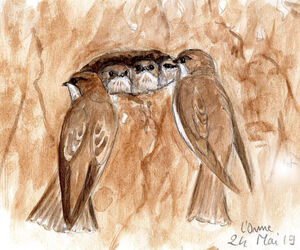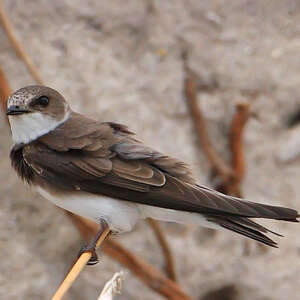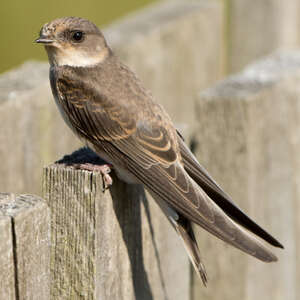Sand Martin
Riparia riparia - Hirondelle de rivage
Identification
The Sand Martin is a small brown swallow, entirely brown on the top, white and brown underneath, very closely linked to water. I specify the habitat because another brown swallow frequents our countries, the Rock Dove, but this one frequents wild rocky habitats.
On the perched bird, the slightly fork-tailed tail ends up at about the same level as the tip of the wings. There are no nets. On the top of the chest, a wide brown collar separates the white throat from the rest of the white underside of the body. The eye, the beak and the feet are black. The juvenile is characterized by clear edges marked on the feathers of the upper parts, to the forehead and even to the pectoral band.
Subspecific information 4 subspecies
- Riparia riparia riparia (North America, Europe to c Asia)
- Riparia riparia taczanowskii (s Siberia and c Mongolia to e Siberia)
- Riparia riparia ijimae (Sakhalin I. Kuril Is. and Japan)
- Riparia riparia shelleyi (Egypt)
Foreign names
- Hirondelle de rivage,
- Avión zapador,
- andorinha-das-barreiras-comum,
- Uferschwalbe,
- partifecske,
- Oeverzwaluw,
- Topino,
- backsvala,
- Sandsvale,
- brehuľa hnedá,
- břehule říční,
- Digesvale,
- törmäpääsky,
- Europese Oewerswael,
- oreneta de ribera comuna,
- Bakkasvala,
- brzegówka (zwyczajna),
- krastu čurkste,
- breguljka,
- Береговушка,
- Layang-layang pasir,
- ショウドウツバメ,
- 崖沙燕,
- นกนางแอ่นทรายสร้อยคอดำ,
- 灰沙燕〔崖沙燕〕,
Voice song and call
Habitat
The Sand Martin is very closely linked to water, mostly to fresh water but also occasionally to coastal areas. It catches insects mostly above water and its surrounding environment. Breeding usually takes place near water, although it can climb up to 2000m altitude if needed - though this is rare. Of course, during migration, it can pass over other environments. Less is known about the conditions in its wintering area in the Southern Hemisphere, but the connection to water is clear.
Behaviour character trait
Flight
Dietfeeding habits
Reproduction nesting
The Sand Martin is a cave breeder for reproduction. It digs a nesting cavity in a soft substrate, usually sandy, silt-clayey or sandy-silty.
Furthermore, since favorable sites are not always plentiful, it does so in a colonial manner. In order to minimize the risk of predation, it chooses a vertical wall or even an overhang. This wall can be natural, a river bank carved by the current, or increasingly often an artificial wall, a river gravel exploitation mostly.The horizontal access tunnel and the terminal cavity are dug in the upper part of the wall and can reach 50 to 70 cm in length. The excavation work is therefore considerable for such a small bird that uses its beak, legs and wings to do so. The work requires fifteen days. The nest is furnished with plant elements from its surroundings and also feathers.
The laying is usually 4 or 5 eggs whose incubation is mainly provided by the female for fifteen days. The male relieves her when she goes out to feed. The young are flying at the age of three weeks. After the flight, the parents recognize their young by their voice within the groups.
Geographic range
The Sand Martin has a Holarctic distribution in the summer. It breeds from Alaska to Kamchatka through North America and Eurasia, reaching high latitudes such as North Cape. It winters south of the Equator, mainly in America and southern Africa, Indochina and the Philippines, but not in Australia.
Threats - protection
IUCN conservation status
concern
in the Wild
threatened
evaluated
Due to its biology (colonial nesting, variability in site availability, difficulty in counting gregarious birds), the population trend is not easy to assess. It can simply be said that the Sand Martin is not a threatened species. The upcoming climate changes could change this.
Sources of information
- IOC World Bird List (v15.1), Gill, F and D Donsker (Eds). 2025-12-07.
Other sources of interest
 Specification sheet created on
15/11/2023 by Jean François
Specification sheet created on
15/11/2023 by Jean FrançoisTranslation by AI Oiseaux.net
© 1996-2026 Oiseaux.net
- Accipitriformes
- Aegotheliformes
- Anseriformes
- Apodiformes
- Apterygiformes
- Bucerotiformes
- Caprimulgiformes
- Cariamiformes
- Casuariiformes
- Charadriiformes
- Ciconiiformes
- Coliiformes
- Columbiformes
- Coraciiformes
- Cuculiformes
- Eurypygiformes
- Falconiformes
- Galliformes
- Gaviiformes
- Gruiformes
- Leptosomiformes
- Mesitornithiformes
- Musophagiformes
- Nyctibiiformes
- Opisthocomiformes
- Otidiformes
- Passeriformes
- Pelecaniformes
- Phaethontiformes
- Phoenicopteriformes
- Piciformes
- Podargiformes
- Podicipediformes
- Procellariiformes
- Psittaciformes
- Pterocliformes
- Rheiformes
- Sphenisciformes
- Steatornithiformes
- Strigiformes
- Struthioniformes
- Suliformes
- Tinamiformes
- Trogoniformes
































